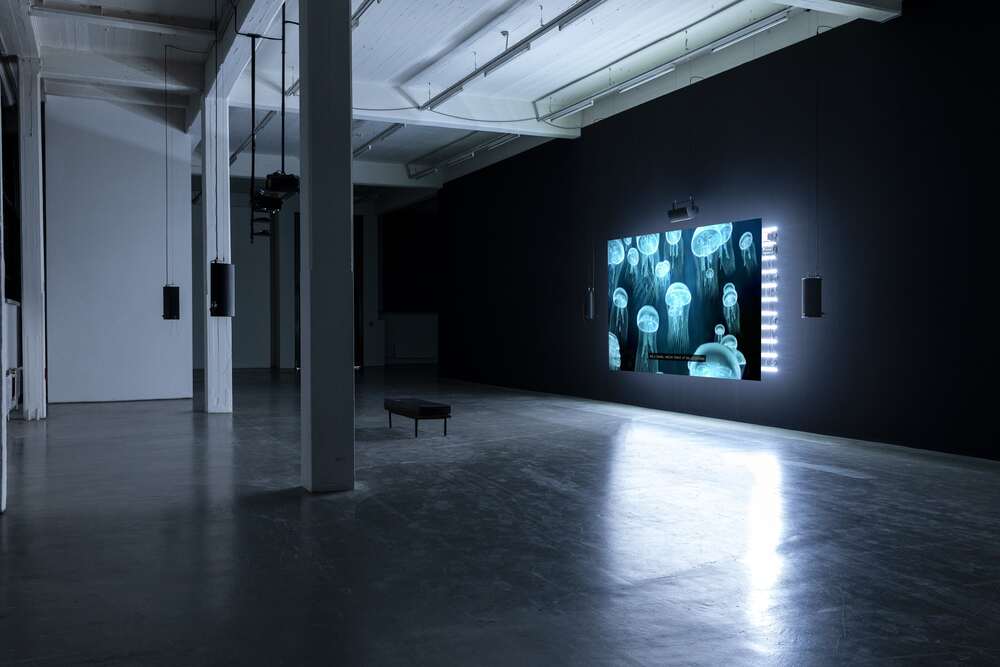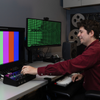On September 25, 2015, Jonathan Farbowitz attended the third edition of Tech Focus, a conference in New York hosted by the Electronic Media Group, a division of the American Institute for Conservation dedicated to time-based media. Little did he know that this event would forever change the course of his career.
“The edition was entirely focused on the preservation of software-based artworks, and it really opened up my mind about the possibilities in the field,” he recalls in an interview with The Overview. “I had never thought about how museums might preserve software-based artworks before. After studying film, I entered the preservation grad program, thinking I would mostly work on video."
Farbowitz realized that the preservation projects introduced at Tech Focus III used tools such as version control software, emulators and virtual machines, technologies he was already familiar with from his work on web applications and video game testing after his undergraduate studies. “That lit a fire in me to learn more about this field,” he says.
Everything fell into place as he naturally followed his interests in film, technology, gaming and digital preservation. This skill set proved to be the perfect foundation for a fellowship in the Conservation of Computer-based Art at the Guggenheim Museum in New York– so he applied and got the job.
The Met’s Mission to Conserve Time-Based Media
Today, ten years after attending Tech Focus III, Farbowitz works as the Conservator of Time-Based Media at the Metropolitan Museum of Art in New York, caring for a collection of roughly 300 media-based pieces made with now obsolete technologies like 35mm slide projectors, Cathode-ray tube (CRT) televisions, VCD players, or LaserDiscs to name just a few.
And as the digital age shows no signs of slowing down, this list of outdated technologies only keeps growing. What, then, happens to the works of contemporary artists who experiment with today’s tools, tools that could become obsolete by tomorrow?
More and more cultural institutions like The Met recognize the need for trained and technically skilled experts like Farbowitz to preserve those pieces of contemporary history for future generations to experience, study, and learn from, just as we do with paintings or sculptures from previous eras.
“The fact that my position became permanent last year shows that The Met has taken a serious step toward committing to time-based media conservation as a discipline within the museum,” says Farbowitz. “Institutions are now willing to put more resources toward the field which is crucial because we could theorize all day, but you need people to do the day-to-day work of actually caring for these pieces.”
And especially for computer- and software-based artworks, this job can be challenging as programs, operating systems, hardware, and programming languages are constantly updated. It also raises questions about authenticity: If the hardware and software of a media-based artwork are altered or replaced due to obsolescence over time, how can museums ensure it doesn’t lose its core identity?
“Media-based artworks are a bit like people”
For conservators of time-based-media like Farbowitz there is no one-size-fits-all solution, as every artwork has its unique features and obsolescence challenges.
In a recent podcast with The Met, he compares them to people: "There’s the baby artwork, then the toddler, the child, and eventually the teenager and they often go through different stages as they’re installed and exhibited more frequently. Sometimes the artist’s opinions on what’s necessary and how to show the piece also change over time. It’s a very dynamic process.” That's why Farbowitz always tries to have the artist be present during installation so they can offer feedback directly.
“We then also create a so-called iteration report, a document that lists all the decision-making around a particular installation of an artwork. So each time it’s installed, and we have the possibility to interview people about the process, it’s all documented.”
Ensuring the ethical preservation of media-based artworks in a museum’s collection is an ongoing collaboration between the conservator and the artist. But what does that process actually look like in practice?
When a museum decides, for example, to acquire a software-based artwork it all starts with a questionnaire sent to the artist to better understand what the work is. According to Farbowitz, that isn’t always obvious, especially with computer art.
“For example, The Met recently acquired a piece called The Critical Dictionary of Southeast Asia by Ho Tzu Nyen. The artist maintains a website that runs a version of the work, but we had to clarify that what we were acquiring was not the website, but the gallery installation version. It runs on a computer placed in a gallery not connected to the internet and it displays the work on a screen with sound, so very different from a website”, explains Farbowitz.

"The questionnaire also asks how important particular equipment is to the conceptual nature of the piece, whether parts can be replaced, spatial requirements, whether the space needs to be carpeted, wall colors, and so on. If the piece generates video, we ask how that video should be displayed, on a projector or a monitor? What kind of speakers are required?” From the questionnaire and the installation instructions, Farbowitz and his team try to understand the technical anatomy.
“Then we create what's called an identity report by recording the elements of the artwork that are not likely to change over time. Some would call it its core identity. If it's a single-channel video, featuring one screen, that's probably not going to change in the future. Maybe the file types will change, or the type of screen it's shown on will, but the artist is most likely not going to add another screen later. So that would be a more core identity part of the artwork”, explains Farbowitz.
“As conservators, we're naturally curious people”
For more complex pieces, there’s often a lot of back-and-forth with the artist. “We tend to do what we call intake or acquisition interviews. In many cases we follow up with questions, that’s often the start of a collaborative discussion. As conservators we're naturally curious people. We want to know the details of everything and we can be very exact.
We also have to try to avoid posing questions that lead the artist in a certain direction. So instead of asking ‘Is it okay if we rewrite this code as a Python script?’ we’d rather ask: ‘How would you see your work being shown in 10 years? How about 50 years?’ So we really let the artist guide us, rather than pushing them into a corner.”
As they understand the work better, Farbowitz and his team can make recommendations about deliverables like specific file types, for example. For preservation masters, they typically request either losslessly compressed or uncompressed video formats. For software-based pieces, they will ask for the source code. “We want to understand the programmed behaviors, and the source code lets us or a hired programmer analyze and interpret how the work functions.”
Farbowitz and his team also check for discrepancies, verify that files function as intended, and assess sustainability. For software-based works, a list of dependencies is crucial, for example software libraries needed to run the work.
“Our relationship with the artist doesn’t really end. We might reach out to them if formats turn out to be unsustainable or if proprietary tools were used like Adobe Illustrator, Photoshop, or Max MSP. For Illustrator, we might export to a more open format and verify that nothing was lost in translation. For Max MSP, a software many DJs use to synthesize sound, or something like Macromedia Director, it’s more complex as you can’t just click the export button to a format that's not proprietary.”
Restoring "Brandon": A Case Study in Software-based Art
During his fellowship at the Guggenheim in New York, Farbowitz's technical skill set allowed him to tackle even the most complex preservation projects. For example, a multidisciplinary team that included Farbowitz, his then supervisor Joanna Phillips, computer science professor Deena Engel, and programmer Emma Dickson restored “Brandon”, a software based artwork by Taiwanese artist Shu Lea Cheang.
The piece, commissioned by the Guggenheim in 1998, was a multilayered one-year narrative web project created by over 50 people between 1998 and 1999. It drew inspiration from the life and tragic murder of Brandon Teena, a 21-year-old transgender man who was the victim of a hate crime in Nebraska in 1993. By 2015, many of the artwork’s elements were no longer working in newer web browsers due to outdated web technologies and an inconsistent codebase.
As part of the Guggenheim’s Conserving Computer-Based Art (CCBA) initiative, the Guggenheim’s Conservation Department unveiled a major restoration of Shu Lea Cheang’s seminal web artwork "Brandon" (1998–99) in April 2017.
During the Brandon restoration, the team applied conservation ethics to keep the "look and feel as close to the original as possible".
To make informed decisions they conducted extensive research to understand the site's history, who made changes, why, the technologies used, and how specific web pages worked.
They delved into Guggenheim papers, emails, invoices, flyers, and press releases, interviewed former curators and examined the code of the file set archive, comparing different versions, analyzing file structure and metadata.
The artwork heavily relied on Java applets for its visual elements, a technology that is obsolete in today’s browsers. So the team decided to rewrite the Java code in JavaScript, which was chosen because it was already used in Brandon's original code, is very durable, and it even allows for much slimmer, more readable code.
Most of the Brandon piece was originally written in HTML 3, and many tags like the blink tag and font tag were deprecated or rendered inconsistently.
For the blink tag, instead of rewriting the HTML, they added JavaScript that selected the existing (ignored) tag and applied CSS styles to make the text blink again. This preserved the original code while restoring functionality.
Farbowitz and his colleagues made sure that every change in the code was transparently documented using in-code annotations, adding explanatory notes or comments directly within the source code and version control software. They also ensured that all changes could be reversed if necessary to restore the original artwork.
This was especially challenging, given the immense catalogue of damages and the thousands of lines of code that needed to be fixed.
Additionally, Farbowitz and the team wrote a detailed treatment report exceeding a hundred pages that listed a summary of the interventions for future conservators.
Visually they included screenshots taken before and after the restoration, as well as narrated video recordings of the site being navigated both pre- and post-restoration.
The Art of Documentation
This meticulous approach to documentation is at the core of Farbowitz’s work. “Conservators of time-based media rely heavily on documentation, perhaps even more than other conservation disciplines. Unlike traditional art forms, computer-based or other time-based media artworks often vary over the years as their installation and presentation can differ when the technology changes. Documentation helps to maintain the integrity of the artwork through many iterations.”
Farbowitz also recommends that media artists working with software thoroughly self-document their work to ensure it can be preserved: “Beyond the technical specifications, a high level description of the work's behaviors, in a narrative form, can be extremely helpful to understand the conceptual goals and parameters of the piece. For very complex software-based artworks, artists can also record a video documentation showing how it functions. This is a great reference for conservators to know what it's supposed to look like when it's working properly".
And what about artworks made using artificial intelligence? Here, documentation is even more important, he says. Whereas other software-based artworks provide the source code as a blueprint, AI algorithms are not necessarily that stable. Therefore, knowing how the artist initially trained it becomes a critical reference point.
That includes documenting the choices made during the training phase, the data used, and the methodology employed which is essential information to defining the artwork's identity and how it should be preserved.
Another important tip Farbowitz shares for the preservation of software-based artworks is the use of clear file and folder naming conventions.
"I’ve come across software-based artworks where the computer contains around ten different files, with names like 'Program,' 'FinalProgram,' 'FinalFinalProgram,' or even 'ReallyFinal.' As a conservator, I look at these and think, 'Which one actually runs the artwork?' So naming conventions go a long way.”
“Approach technology with humility”
Beyond the practical issues of documentation, preserving software-based art is really about constantly adapting and also embracing new technology as it comes along. “I think one of the most promising developments in this field is the practical use of emulators, a new tool in our belt that allows us to run vintage software on a contemporary computer. That’s very powerful for art conservation as we don’t rely on the original computer to function in order to exhibit the piece, which makes our work a lot easier.”
Since Farbowitz’s first foray into digital art preservation ten years ago, the field has matured thanks to the support from institutions, open-source initiatives, and interdisciplinary collaboration.
Being a conservator of computer-based art is a commitment to perpetual learning,” says Farbowitz. He learned this lesson from his mentor, Joanna Phillips , who served as Senior Conservator of Time-Based Media at the Guggenheim during his fellowship.
“When it comes to technology, you really need to exercise some humility, admit what you don't know and find people who can teach and help to guide you, because you never know what the museum will collect next and what new challenges you’re going to face.”
Words: Eva Bolhoefer





